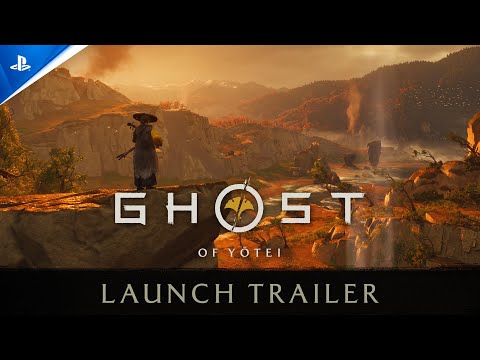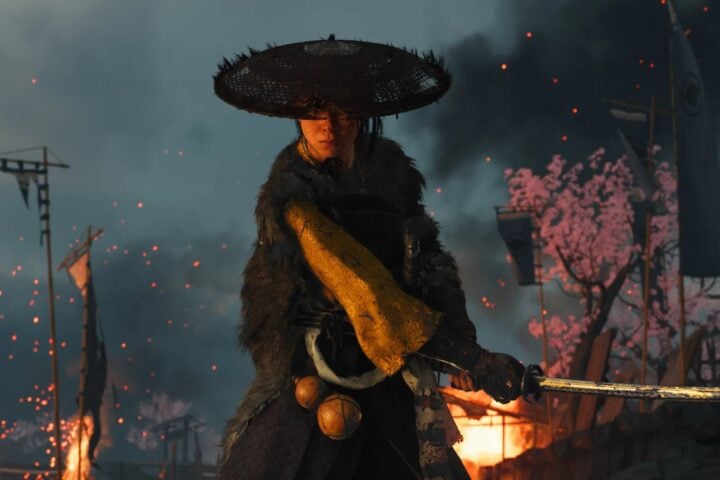Sucker Punch’s Ghost of Tsushima was defined by its protagonist’s hesitance, even when dealing with monsters, to do what needed to be done by any means necessary, for fear of betraying his uncle’s calls for honor. Not that any of that stopped the player from slaying armies of Mongols for hours on end, but the constant push and pull between the exhilaration of revenge and the moralizing of the story cast a pallor over players taking any joy in their work.
Atsu, the fierce, indomitable angel of death you control in Ghost of Yōtei isn’t gripped by any such internal conflict. Right from the first moments of the game, where Atsu strolls through a village and crashes a drunken party hosted by a murderer wearing a snake mask, the message is clear: There are six people who did a horrifying thing to Atsu and her family, they’re doing that exact thing to the entire populace of the Japanese island of Ezo, and they will pay in blood.
Ghost of Yōtei’s clarity of vision is in aid of creating one of the grandest tales of stylized vengeance ever to grace a screen, with very little getting in the way of Atsu and her bloody satisfaction, least of all reality. Here, Ghost of Tsushima’s vaunted Kurosawa black-and-white filter is joined by a bloodier, dirtier mode inspired by Miike Takashi’s gloriously brutal action thriller 13 Assassins, as well as an optional lo-fi hip-hop soundtrack mode inspired by Watanabe Shinichiro’s Samurai Champloo composed by Watanabe himself.
Right out of the gate, Ghost of Yōtei signals that Atsu’s tale is closer to legend than history, which isn’t to say that Sucker Punch doesn’t respectfully nod to the latter. For one, the game cares to remember the existence of the Ainu people, even if it doesn’t get into why and how the Matsumae clan of samurai has them herded into a tiny chunk of the Ezo region of Japan where the game takes place. But the developers signpost early and often that there’s more anime and Hollywood western in this game’s blood than there was in Ghost of Tsushima, setting the stage for players to become the thing that children talk about when trying to scare each other at night.

All the tools are at Atsu’s disposal to become a phantom out for the blood of the unjust, to make them fear the sound of a shamisen playing on the wind, especially with the vicious, throat-ripping wolf companion who follows respectfully behind her. If the birds Atsu has to follow to secret areas in this game were black, this could easily be a Japanese retelling of The Crow.
The elements that worked in Ghost of Tsushima—the dynamic brutal combat, the exploration focused on studying the breathtaking environments and not icons on a map, the duels playing off of the literal release of tension—have all returned, refined even further to reflect how much angrier of a character Atsu is than the earlier game’s protagonist. No task, no matter how small, is meaningless to the overarching story, every moment a new opportunity to strike fear in Atsu’s enemies. The smaller quests all emphasize the feeling of playing as a wandering avenger, adding to their legend with every peasant saved, every outpost liberated, and every warlord slain.
There’s plenty to be said for how patient Ghost of Yōtei’s story unfolds in regards to the various well-written adventures, myths, legends, and tiny moments of heroism across the campaign. The larger narrative twists and turns are defined by the way they deliver mega-sized, often delirious dozes of bloody catharsis. And all of it would be meaningless if not for Erika Ishii’s powerhouse of a performance as Atsu. What could very easily have been a one-note taciturn growler of a protagonist gains ever so much more nuance, subtlety, and a very-modern, uncompromised sense of righteous, focused anger in their hands.
That’s especially true as the story has Atsu learn some hard truths about her targets, and slitting their throats no longer feels like the most correct option. There’s no conflict in Atsu’s heart about what must be done, but as the game progresses, there’s a broadening understanding of what created the monsters she hunts, and the monster Atsu is making of herself. Throughout Ghost of Yōtei, Ishii’s voice and mocap performance has to walk a tightrope between giving voice to Atsu’s justified anger and the sympathy that bubbles up in her. It’s captivating to behold how Ishii so empathetically switches back to a mode of glorious hate and venom at the drop of a hat without making it seem incongruous. It’s a star-making turn worthy of Atsu’s legacy.
This game was reviewed with a copy purchased by the reviewer.
Score:
Developer: Sucker Punch Productions Publisher: Sony Interactive Entertainment Platform: PlayStation 5 Release Date: October 2, 2025 ESRB: M ESRB Descriptions: Blood and Gore, Drug Reference, Intense Violence, Language, Partial Nudity, Use of Alcohol Buy: Game
If you can, please consider supporting Slant Magazine.
Since 2001, we’ve brought you uncompromising, candid takes on the world of film, music, television, video games, theater, and more. Independently owned and operated publications like Slant have been hit hard in recent years, but we’re committed to keeping our content free and accessible—meaning no paywalls or fees.
If you like what we do, please consider subscribing to our Patreon or making a donation.


AloJapan.com